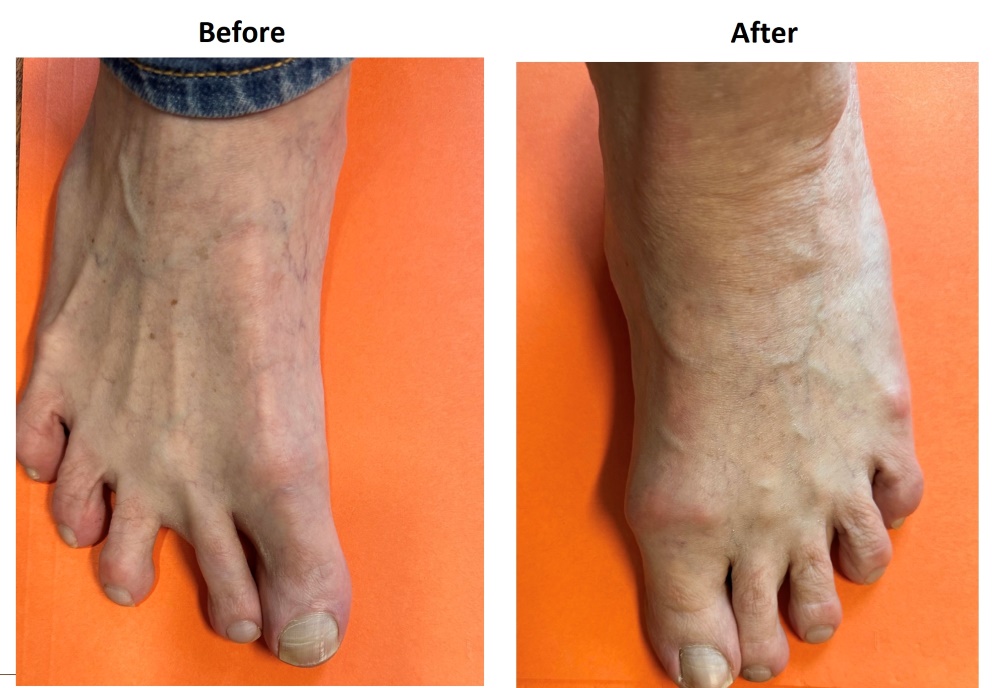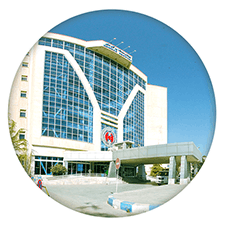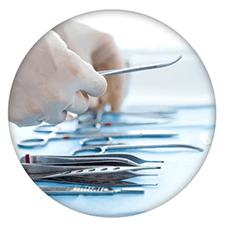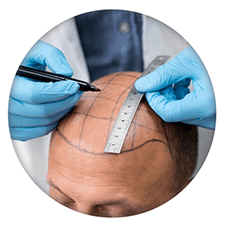Bunion Surgery In Iran

Bunion surgery in Iran is the only treatment to cure the big toe and forefoot deformities, called Hallux Valgus, in medical terminology. The hallux is a term for the first or the big toe. A valgus hallux deviates toward the outer part of the foot (and, in some rare cases, is shifted inward), which will get painful over time. Furthermore, if not treated on time, hallux valgus can extend over the entire foot, or even the lower limb, with cramps or functional overload in the joints (knee, hip, back), and cause them to work in poor conditions. This disorder may affect women of all ages under certain circumstances.
Surgeons may suggest different types of bunion surgery under specific conditions. The extent of the bunion, the candidate’s age, overall health, degree of daily activity, and the quality of the bones and connective tissue all influence the surgical technique. Based on the candidate’s condition and the clinic’s equipment, the surgeon may select one of the three procedures: Exostectomy, Osteotomy, and Arthrodesis. The majority of patients who undergo these types of surgeries recover with significant pain relief. The procedure also enhances the alignment of the big toe. So, you can walk effortlessly after undergoing bunion surgery.
Although most people assume that only patients with a drifted big toe need to undergo bunion surgery, doctors might suggest this procedure even for other cases. Toe pain that interferes with your day-to-day activities and persistent swelling and inflammation in the first toe are examples of other conditions that can lead to bunion surgery. In this case, the first step is to find a medical clinic for initial medical visits and, if necessary, to get this surgery.
There are various options for you as a potential bunion surgery candidate. You can count on particular destinations to discover affordable and high-quality options, like bunion surgery in Iran, among all the hospitals and medical clinics worldwide. Different types of Hallux Valgus treatment are performed in equipped hospitals around Iran under the supervision of experienced doctors at a reasonable price. Medical providers can also assist you with this; For instance, Happy Green Life company is a reliable option For a more convenient medical journey all around Iran.
What is bunion surgery?
Following the discussion of bunion surgery in Iran and its merits, it is essential to make a general understanding of Hallux Valgus and various surgical treatments for this problem, called bunion procedures.
An expansion of the bone or tissue around a joint at the base of the big toe or the bottom of the little toe is known as a bunion (hallux valgus). This condition is also called “bunionette” or “tailor’s bunion” in medical terms. Bunions frequently develop when the joint is pressured over an extended period. Ladies are more likely to get bunions due to their propensity for choosing constricting, pointed, and tight shoes. Still, several factors may contribute to a bunion.
Getting bunions could run in the family. Arthritis can also cause bunions that affect the big toe more likely. As a result of this issue, you may experience pain, particularly when your big toe rubs against your middle toe or while wearing shoes. Additionally, a misaligned big toe can occasionally cause pain in the ball of the foot.
Bunion and hallux valgus are general terms for referring to many problems related to the big toe formation. Professionals suggest various treatments for each situation, considering several factors. It is also possible to have a non-invasive treatment for this problem. Still, in some cases, bunions can be treated through an invasive procedure called Bunion surgery, also known as “Bunionectomy”. It is done to solve the discomfort and cure the deformity. There are various bunion surgery procedures. Most involve realigning the big toe to reduce pain and enhance function.
Is Surgery Right for You?
Generally speaking, surgery is not necessary if your bunion is not hurting. Even though bunions frequently enlarge with time, doctors do not advise surgery to stop bunions from getting worse. With the proper footwear and other protective methods, many people may slow the growth of this condition, so the situation never results in discomfort or other issues. Even if there was no bunion pain before surgery, there is a chance that the affected toe will continue to experience pain after the procedure. The purpose of bunion surgery should not be cosmetic.
The following characteristics are common among most bunion surgery candidates:
- Significant foot pain:
It prevents them from walking or wearing appropriate footwear, among other daily activities. Even in comfortable shoes, they might struggle to walk more than a few blocks without feeling excruciating discomfort;
- Inflammation and swelling of the big toe:
This type of swelling doesn’t go away with rest or taking medicine;
- Toe deformity:
The malformation happens when the big toe drifts inward toward the smaller toes, potentially causing the toes to cross over one another.
Different Types of Hallux Valgus
After bunion surgery in Iran, most candidates will be cured completely and relieved of pain. Still, some surgeons do not recommend an invasive procedure like bunion surgery in mild cases that will be treated with other optional methods. In the first stage and before considering the surgery as a required cure, your healthcare professional can recommend putting on comfortable, well-fitting shoes. They also might recommend you to utilize splints and orthotics (special shoe inserts fitted to your foot) to reposition the big toe and add padding. Furthermore, the discomfort and swelling associated with arthritis-related bunions may be lessened with medication, so the doctor might also prescribe specific drugs.
There is a possibility that your healthcare practitioner will recommend surgery if these treatments are ineffective. This usually makes the issue go away. In this case, surgery aims to alleviate pain and minimize deformity. However, the procedure is not intended to enhance the appearance of the foot and is not a cosmetic one in nature. There are many factors that determine which surgical technique is used, such as the extent of the bunion, your age, overall health, degree of activity, and quality of your bones and connective tissue. The severity of the problem and the size of the patient’s bunion determine which category the condition belongs to:
- Mild bunion;
- Moderate bunion;
- Severe bunion;
- Arthritic bunion or big toe joint.
Various types of bunion surgery
Bunion surgery is a general term for several invasive methods of bunion treatment. The extent of the bunion, your age, overall health, degree of activity, the hospital’s equipment, and the quality of the bones and connective tissue all influence the type of surgical technique that is carried out. It is also worth mentioning that all kinds of bunion surgery in Iran are available thanks to its well-equipped hospitals.
It is your physician who examines various factors and suggests the proper procedure. It will probably be one of the methods below:
Osteotomy
The most common treatment for bunions is osteotomies. It is typically carried out in combination with soft tissue treatments since both are required to maintain the alignment of the big toe. To treat the abnormality, osteotomies can be done at various locations along the bone. Sometimes a tiny wedge of bone is removed in addition to cutting the bone to give enough correction to straighten the toe.
During this procedure, your doctor makes tiny bone cuts to align the joint. They may first cut the bone and then use pins, screws, or plates to repair the new fracture. As a result of the joint adjustment, the bones are now straighter.
Arthrodesis
The arthrodesis, also known as joint fusion, is typically performed on patients with severe arthritis or bunions. It involves joining two bones together at a joint. Besides the regular candidates, patients who have undergone unsuccessful bunion surgery in the past are other potential candidates for this process, too.
During this procedure, the diseased cartilage is removed, the bone ends are severed, and the two ends of the bone are joined together to form a single solid bone using an internal fixation made of metal. As a result, the joint no longer moves but is stable, and most importantly, instability no longer causes discomfort.
Exostectomy
Another common type of bunion surgery in Iran is Exostectomy, the surgical removal of a bony outgrowth. Exostectomy is typically performed as a component of a more extensive corrective surgery that includes soft-tissue and osteotomy treatments. However, if a doctor only performs an Exostectomy without an osteotomy, the bunion deformity might reappear. Usually, only minor bunions are treated with this procedure.
During this treatment, your doctor will remove the swelling from your toe joint. Exostectomy is rarely utilized as a standalone bunion treatment because this technique does not straighten the joint. It also fixes the bunion’s underlying condition, even when paired with soft tissue surgeries.
Resection Arthroplasty
Various cases, such as elderly candidates, patients who have had unsuccessful bunion surgery, or patients with significant arthritis that cannot be treated with an arthrodesis, typically undergo resection arthroplasty. Still, this treatment is not frequently advised because it can affect the big toe’s ability to push off. During this surgery, your physician will remove the damaged joint tissue and then tend to fix the problem. By doing so, the gap between the bones is widened, and a flexible “scar” joint is produced.
How To Prepare For Bunion Surgery?
Before the procedure, the candidate is required to visit the doctor for a physical checkup. They will evaluate their health and look for any issues that might cause a risk. candidates will also require a preoperative medical clearance from their primary care physician if they have a heart or lung issue, a chronic sickness, or other similar medical conditions. Then, the healthcare professional will walk the candidate through the treatment and give them the chance to ask any questions they may have. During this time, the Happy Green Life health provider will set several visits to get in touch with your health provider to familiarize yourself with bunion surgery in Iran and its distinct stages.
Before bunion surgery, the surgeons may also suggest several medical tests to ensure the candidate’s health and minimize potential risks. It consists of a chest x-ray, a cardiogram, and blood counts. A urine sample will also be required. Your doctor may suggest a specific foot x-ray to arrange your operation correctly. These x-rays should be obtained while standing and bearing weight to see the foot abnormality clearly.
The following tips are also crucial prior to Bunion Surgery In Iran:
- Before the procedure, you might be instructed to fast for eight hours;
- Before the surgery, you can take a sedative for relaxation. You will need to make arrangements for a driver to take you home because the sedative might make you feel sleepy;
- Inform your medical professional if you have any sensitivities or allergies to any medications, latex, tape, or anesthetics (local and general);
- You must let your healthcare practitioner know if you are pregnant or suspect that you are;
- Notify your doctor about all medications you are taking, both prescribed and over-the-counter, as well as any herbal supplements;
- let your doctor know about any bleeding disorders, anticoagulant medications, aspirin, or other medications that might cause bleeding disorders.
- Depending on your medical situation, your healthcare professional might ask you for any other preparation.
The Bunion Surgery procedure
Bunion surgery in Iran, like other destinations worldwide, stands as a three-stage procedure. The last section introduces preparing for this surgery as the first step to experiencing a more successful medical course. The rest of this procedure, containing the steps during surgery and after it, will vary depending on the types of bunion treatment selected. However, all of these methods share a few steps.
During Bunion Surgery In Iran:
A bunionectomy may be performed in an outpatient setting or, less frequently, as a part of a hospital stay. Depending on your situation and the methods used by your healthcare professional, procedures may vary.
For bunion surgery, many patients don’t require a general anesthetic. An ankle block, a type of local anesthetic, will be injected in its place instead. You become numb below the ankle after an ankle block, although you remain conscious during the procedure. Upon numbing your foot, the orthopedic surgeon will start the medical course by removing the bunion and making the necessary repairs. The surgeon usually sets the toe in place using the tools below:
- Wires;
- Small screws;
- Metal plates.
Osteotomy, exostectomy, and arthrodesis are the three most common bunion removal practices. Each of these procedures retains detailed steps as the nature of every medical surgery. During each course, the following may occur:
- During an arthrodesis, your surgeon will replace the injured joint with screws or metal plates to treat the deformity;
- During an exostectomy, the orthopedic surgeon removes the bunion without aligning the joint;
- During an osteotomy, the surgeon will cut the big toe joint and reposition it to its usual place.
The Bunion Surgery In Iran can take a while, depending on how much of your foot is misaligned. If you need more than one osteotomy or if the deformity is more severe, surgery will take longer. There is no need to be concerned if your operation takes longer than expected because every bunion correction is slightly different. To aid in the appropriate healing of the wound, the surgeon stitches, and bandages your toe before guiding you to the recovery room. Usually, after a few hours of recovery, you can return home.
After bunion surgery
Following Bunion Surgery In Iran, you will be brought to the recovery room for monitoring following your procedure. Depending on the type of anesthetic used, your recovery time will vary. You will be brought to your hospital room or released once your breathing, blood pressure, pulse, and cardiac rhythm are all stable and you are awake. How closely you adhere to your surgeon’s instructions at home in the initial weeks following surgery will significantly impact the procedure’s outcome. You must also visit your doctor frequently for several months, sometimes up to a year, to ensure that your foot recovers appropriately.
For the first few weeks following surgery, your doctor will provide detailed instructions to care for your foot at home. You might leave the hospital with a cast or particular surgical shoe to keep your foot safe. As soon as you get home, you must relax and elevate the foot on one or two pillows to relieve the discomfort and swelling. You might also be instructed by your healthcare provider to use ice and limit your walking. Following surgery, you might be advised to use a walker or cane. Avoid standing on your feet as much as you can. If necessary, you can drive after a week or two. However, this is not recommended.
After Bunion Surgery In Iran, the dressing must be kept dry and clean. You should wrap the bandage and seal it with plastic tape when taking a shower. You may take a sponge bath as an alternative. The stitches will be taken out at the follow-up appointment, which is typically planned for around two weeks after surgery.
After removing your bunion, be prepared for your foot to swell somewhat for several months. You can reduce your pain by wearing shoes with enough room. After releasing their bunions, women should attempt to avoid wearing high heels for at least six months. You may follow your doctor’s advice and take a pain reliever whenever you feel pain. Aspirin or other similar painkillers may make bleeding more likely, so only take prescribed medications. Your doctor may also recommend antibiotics to avoid infection after surgery. Please, take all of them as directed by your physician. Physical therapy may be recommended, too, where you’ll learn exercises to strengthen your foot and lower leg; you should tend to undergo them regularly.
Bunion surgery Complications
As with any surgical procedure, bunion surgery has its risks. These are uncommon and usually manageable; however, they occasionally prevent or delay your entire recovery. Before bunion surgery in Iran or any other destination, your surgeon will review the risks and take special precautions to avoid complications. However, the following are some potential risks that may happen after the surgery:
- Infection;
- Swelling;
- Ongoing pain or stiffness
- Nerve injury;
- Numbness;
- Bunion recurrence;
- An unhealed bone;
- Problems with wound healing.
Depending on the individual medical state of each candidate, there might be additional dangers. Before the treatment, candidates should share any worries they may have with the healthcare professional and try to remain relaxed for their surgery; this may prevent potential risks and relieve the worries.
Bunion surgery in Iran
A bunion’s unattractive and occasionally painful appearance can be treated with a sophisticated but successful procedure called bunion surgery. A skilled foot and orthopedic ankle surgeon who performs this operation can achieve excellent results.
Happy Green Life, as a well-respected health tourism service in Iran, offers hand-selected most-respected Iranian orthopedists for every candidate worldwide with bunion-related problems. With the guidance of this health tourism provider, patients can rely on a well-managed journey tailored to their medical condition. In various ways, Iran is a popular destination for orthopedic patients. By choosing Iran, you can be confident that you will receive top-notch care at clinics with modern medical facilities and under the supervision of qualified physicians. Additionally, you will be given a competitive price much lower than any other country with the same quality.
You can always have access to all our services in one place, Click here!
































